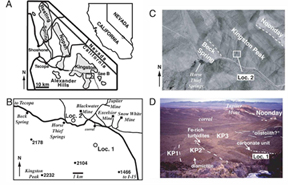Geotimes

Web
Extra Friday,
April 18
Microfossil lineages support
sloshy snowball Earth
Scientists studying the snowball Earth hypothesis have two very different models:
one hardball and one slushball. The hypothesis suggests that large segments
of Earth's surface were frozen over during the Neoproterozoic (about 900 to
540 million years ago), and that the glacial periods were followed by rapid
and intense greenhouse warming, acid precipitation and deposition of extensive
carbonate deposits, or "cap carbonates." This idea has attracted significant
research attention since it was initially proposed in 1998.
It remains controversial, but many earth scientists believe that Earth experienced
several significant glaciations between 700 and 540 million years ago. Whether
Earth's surface was completely frozen over during the glaciations (a hardball)
or experienced open water near the equator (a slushball) is up for debate. A
recent paper in the Proceedings of the National Academy of Sciences (PNAS)
now suggests that slushball conditions were more likely.
The two scenarios would have differed in the severity of their effects on the
evolution of life. Complete coverage of ice and snow around the globe would
have decimated many ancient lineages of life, says Alan Jay Kaufman, a geologist
at the University of Maryland and one of the co-authors of the 1998 Science
paper suggesting a snowball Earth. "Only the most extremophilic bacteria
would have been able to survive the snowball Earth and repopulate the planet
afterwards," Kaufman says.
Even with some open water, however, slushball-like conditions would not have
been easy for life. The chances, though, for a more diverse array of multicellular
life forms to evolve would have been greater, according to the recent research.
 In the
PNAS study, Frank Corsetti of the University of Southern California,
and Stanley Awramik and David Pierce of the University of California, Santa
Barbara, examined microfossil lineages from the Neoproterozoic Kingston Peak
Formation in Death Valley, California. The strata span what is known as the
Sturtian glaciation (750 to 700 million years ago). The researchers believe
the deposits formed within 10 degrees of the equator, but acknowledged some
uncertainty on that point.
In the
PNAS study, Frank Corsetti of the University of Southern California,
and Stanley Awramik and David Pierce of the University of California, Santa
Barbara, examined microfossil lineages from the Neoproterozoic Kingston Peak
Formation in Death Valley, California. The strata span what is known as the
Sturtian glaciation (750 to 700 million years ago). The researchers believe
the deposits formed within 10 degrees of the equator, but acknowledged some
uncertainty on that point.
Locality information for the study area,
Kingston Range, eastern California. View larger version here.
"The effect of low latitude glaciation on life has been predicted to be
extreme … but little or no fossil evidence from the interval in question
has been brought to bear on the issue," Corsetti says. "We bring the
fossil record to the debate. Our data would suggest that microbial diversity
in prokaryotes and eukaryotes was nearly identical before the snowball and during
the snowball. That is, the predicted crash in the biosphere is not supported
by our data. This led us to conclude that the climate was not as severe as predicted
by some of the snowball hypotheses or that life is much more resilient than
we thought," he adds. In their paper, Corsetti and his colleagues concluded
that slushball conditions were more probable.
Kaufman agrees. Hardball conditions, he explains, would have decimated many
ancient lineages, particularly among eukaryotic organisms — those that
gave rise to what we now know as animals, plants and fungi. "If the snowball
Earth was such a dire event for life you would not see the same lines of eukaryotes
before and after the event," he says.
Gabrielle Walker, author of a book on the snowball Earth hypothesis (Snowball
Earth, Crown Books, 2003) says that the results are not that surprising.
She explains that while many species would have gone extinct during the snowball
episodes, some would have survived in safe havens, which scientists call refugia.
Corsetti, however, downplays the idea that the strata he and his colleagues
studied were merely a refuge. "This is highly unlikely, given the difficulty
in finding microbial fossils in the first place, let alone stumbling across
a purported refugia," he says. Still, given the low level of detail that
can be seen in microbial fossils, Corsetti acknowledged difficulty identifying
individual species. This could be problematic for some, but he does not think
identification problems pose critical problems for their analysis.
"Most of us would agree that Earth got cold enough for ice to form at
the equator at least twice in Neoproterozoic time and that the direct aftermath
of the cold times was highly unusual," Corsetti says. This was manifested
by the isotopic anomalies and the unusual carbonates capping the glacial units,
he adds. "From this point, no one agrees on anything. The debates are far
from over, I suspect. But that's what makes it interesting."
Dave Lawrence
Geotimes contributing
writer
Links:
PNAS
abstract
Frank
Corsetti's home page
Snowball
Earth by Gabrielle Walker
 In the
PNAS study, Frank Corsetti of the University of Southern California,
and Stanley Awramik and David Pierce of the University of California, Santa
Barbara, examined microfossil lineages from the Neoproterozoic Kingston Peak
Formation in Death Valley, California. The strata span what is known as the
Sturtian glaciation (750 to 700 million years ago). The researchers believe
the deposits formed within 10 degrees of the equator, but acknowledged some
uncertainty on that point.
In the
PNAS study, Frank Corsetti of the University of Southern California,
and Stanley Awramik and David Pierce of the University of California, Santa
Barbara, examined microfossil lineages from the Neoproterozoic Kingston Peak
Formation in Death Valley, California. The strata span what is known as the
Sturtian glaciation (750 to 700 million years ago). The researchers believe
the deposits formed within 10 degrees of the equator, but acknowledged some
uncertainty on that point.
